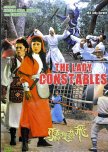
This review may contain spoilers
"We live in a fishbowl, and people love to talk."
Sisters of the Gion tackled a familiar subject for this particular era among directors who were critical of the class structure and state of women. Omocho and her older sister Umekichi were geishas who had different approaches to their work. Both thought they knew the best way to navigate their difficult existence. Only time would tell who was right.Umekichi's patron, Furusawa had recently gone bankrupt and left his wife and children. He moved in with the sisters much to the younger sister, Omocho's, chagrin. The more traditional Umekichi felt an obligation to Furusawa. Omocho was the exact opposite. Men used them for what they could get out of them, she felt they should do the same to men. She hated men's predatory behavior and was willing to do whatever was necessary to gain a patron and stable lifestyle. Behind in their rent and unable to buy one good kimono between the two of the them, their new houseguest was a luxury they could not afford. Omocho worked to find both of them patrons and enough money for Furusawa to take the train back to his wife.
In the process of procuring a silk kimono and gaining a patron, Omocho made a dangerous enemy. Umekichi also found out how important she was to Furusawa when his fortunes changed.
Sisters of the Gion was an interesting look at the life of rank and file geishas in a time when their popularity was waning. The sisters were on the bottom rung of society and struggling to make ends meet, depending on men's needs and money to provide for them. Though one sister played by the rules and the other tried to be more independent, both were stuck in a world neither wanted to be in but with very few options for a way out. Director Mizoguchi never candy coated their miserable existence nor did he make Omocho vicious in her intentions. The women were dependent on whatever they could gain from their male clientele, men who could use them or forget them on a whim. It was no wonder Omocho despised the men she had to enthrall in order to eke out an existence. Like everyone she wanted to feel safe, but with her low status that entailed a great deal of risk.
Some of the director's choices could make it hard to connect with the characters. The camera was often set up high and at a distance which made it difficult to see facial expressions. This was complicated even more when a character had their back to the camera. It's not easy to feel empathetic when you can't see how characters are feeling. Fortunately, Yamada made good use of her voice to reel this viewer in. There were only a couple of scenes with a close-up, one put to good use in the final scene when Omocho let loose a tirade of despair and agony too long held back.
Yamada Isuzu had the strongest performance as the modern, more feminist sister bent on securing them a better life. The story gave her plenty to work with. Umemura Yoko was saddled with playing the demure, compliant sister willing to do whatever her former patron needed, making sure he was happy and comfortable even at the loss of her own happiness and comfort. The men came across as largely interchangeable. Given the theme, that may have been by design.
At times cynical, at other times humorous, SotG refused to serve the viewer up a happy or hopeful ending. Despite the sisters' opposing philosophies, both failed. Both suffered. In the end, neither gained anything for their troubles except more trouble. The final scene while cathartic, also came across heavy-handed as the director spelled out his opinion of the sisters' status. Despite the difficult topic, Sisters of the Gion is a film worth seeking out if you like older films and especially this gifted director's works. Sisters of the Gion won the Kinema Junpo Award for Best Film in 1937.
11/10/22
Was this review helpful to you?

This review may contain spoilers
Are you better off with him or without him?
In this film, Director Naruse took the viewer behind the scenes of two performers, delving into their professional and personal lives. Jurio and Toyo had been together since training under her mother and must now decide whether to marry and continue on or break up the act.This was a difficult film for me to rate so I will simply list some pros and cons.
Cons:
Jiro was an egotistical jerk who constantly criticized Toyo's shamisen playing but never reflected critically on his own performance.
Toyo was told repeatedly that as the woman it was her duty to capitulate to Jiro's demands.
If you don't enjoy or have a background in these types of performances, they can be less than enthralling and there are plenty of them. On the converse side if you enjoy them, you are in for a real treat!
There is a lot of bickering between the main couple
Pros:
Toyo rarely capitulated and often defended herself well against Jiro's barbs standing up to him and their manager.
This was a love triangle with real stakes, there was no foregone conclusion who Toyo would eventually end up with.
Toyo truly loved performing and struggled with whether to give it up in an era when being married and continuing to work were not always compatible. I liked that she wasn't ready to jump on the marriage train simply because it was expected of her. She was also willing to do what was necessary once she made up her mind.
As much as I've enjoyed other Naruse films, I can't say that l enjoyed this one. I never liked Jiro, he was self-absorbed and felt the world revolved around him and his "talent". I sympathized with Toyo's plight, especially during the times she was living in. Jiro may have gotten some comeuppance which led to a modicum of personal growth, but it still wasn't enough for me to care about him. I kept wanting to tell Toyo, "Run girl, run for your life!"
The performances were well done, Hasegawa Kazuo and Yamada Isuzu, here in their youth showed why they would go on to have lengthy careers. If you are a fan of either, enjoy the shamisen, a creative love triangle, or are a Naruse fan, this is a film worth checking out. It may not have been captivating, but it had some entertaining moments.
11/5/22
Was this review helpful to you?

This review may contain spoilers
"Gamera! You're so cool!"
When watching Gamera vs Jiger it helps to remember that this was a 1970 Kaiju movie aimed at children. Gamera meets his match with Jiger and even gets impregnated! And yes, still a children's movie!Two young boys are once again featured and do their part to save the world and Gamera from destruction. They weren't as annoying as some of the kids in previous movies so that was a win.
The film takes place at the Osaka Expo Center where 70 different countries have set up their science exhibits. One of the groups wants to transport an ancient statue from Wester Island to the Expo despite the protests from a chief that it is cursed. Doesn't take long to figure out what the curse is, because not long after they pull up the statue and cart if off Jiger appears and has it out with Gamera. The crew transporting the statue becomes mysteriously sick. Jiger takes Gamera down by propelling spikes into his elbows and knees leaving the big tusked turtle helpless on his back. After immobilizing his enemy, Jiger becomes a speeding hydroplane heading to Japan and destroying any ships in his way. Gamera is not one to stay down long and follows Jiger to Japan where he is rampaging. This time Jiger drives a long spike into the tusked hero, impregnating him with a Jiger larva and seemingly killing him. Didn't even buy the big guy dinner!
The kids and their mini-submarine take a Fantastic Voyage (1966) into Gamera's body to find the mini-Jiger. They, of course, discover how to destroy the giant Jiger and it has to do with the statue. They manage to reanimate Gamera and get him back into the fight.
Gamera vs Jiger was actually not bad for a children's Kaiju from this era. Even Godzilla was aiming his movies at kids during this time. Gamera had a formidable foe in Jiger. Jiger had numerous weapons, even one that could turn humans into skeletons! The monster suits were decent for this time period. The action was close to non-stop, the kids weren't annoying, and the monster fights were creative with the limited funds and limited special effects capabilities. Most of the acting was bearable as was the kids always riding to the rescue. It was a common theme in these old children's movies so best to roll with that aspect. You may grow tired of hearing the Gamera theme song repeatedly sung by the end, "Gamera, you're so cool!" Other than that, if you enjoy Kaiju movies from this era, Gamera vs Jiger is one to try if you can keep your expectations low. As always, I grade these old niche movies on a curve.
10/26/22
Was this review helpful to you?

This review may contain spoilers
It's turtle vs squid!
I don't know what bills or gambling debts Gamera had to pay for him to get involved with this movie, but he should have passed and hibernated somewhere until it was safe to come out. Gamera vs Viras had an okay beginning and an okay end, but the middle was largely comprised of clips from previous Gamera movies which was a huge letdown. And the okayish parts were bad enough the giant turtle should have called his agent and fired him for signing him up for this awkward mishmash of clips. Plus, he had to take a backseat to two Boy Scouts and was only vaguely the star of his own movie. It's enough to make an amphibian rampage on Tokyo---in black and white and in color!Aliens decided Earth was a good place to colonize only they ran afoul of Gamera in space. Long story short, they kidnap two precocious Boy Scouts so they can attach a control chip to Gamera and have him do their bidding. And thus begins the barrage of city destroying clips from previous movies, badly spliced together. Eventually, it's revealed the aliens are big squids and finally near the end of the movie Gamera is able to make fried calamari.
The Boy Scouts weren't as annoying as other kids in Kaiju movies, at least I wasn't rooting for a monster to eat them. If you want a shortcut to catch up on the previous movies, you can watch this one, otherwise, only if you are a huge Gamera fan-or maybe calamari.
10/21/22
Was this review helpful to you?

This review may contain spoilers
Run for your life!
This is an independent film that was intended to be the last in the Raiga/Reigo trilogy. It was more of a fan service made on the cheap and perhaps a Kaiju satire? It’s only for die hard Kaiju fans that are completionists.Normally, I’d give some of the story, but the story boils down to water loving Raiga is challenged by lava loving Ohga with two cities for their fight grounds. A variety of defense groups work to stop them. The Prime Minister was hoping one town would be destroyed by the Kaiju or the defense forces so he could scoop up cheap property and build a casino. Oh, and the Blues Brothers show up, too.
Many weapons made out of childrens’ toys IRL are deployed against the monsters. The acting is akin to what you would find in a 20th century Saturday morning television show, if they cussed and died. There was a lot of repurposing of monster action from previous Raiga movies.
No loving shots of guys in rubber suits demolishing buildings and oil refineries. Instead there were rubber toys with cheap home computer overlays and designs substituted for movement and action. Lots of squiggly lines, blurriness, fireworks, color splats, and fire over the monsters and weapons. How bad was it? Really, really bad.
They must have run out of money for real actors because they used action dolls to take their place for a super secrety secret group, something like the movie Thunderbirds.
If you can enjoy it for the complete bonkers, cheap, over saturated, bad acting, almost incomprehensible story with terrible computer graphics you might want to try this one but better safe than sorry and skip it. Or better yet, run for your life!
10/13/22
Was this review helpful to you?

This review may contain spoilers
#Justice for Manda!
Godzilla royalty-director Honda Ishiro and composer Ifukube Akira were behind the Kaiju and Sci-fi movieAtragon. Given that pedigree I expected it to be better. With all the allusions to the destroyer goddess Manda, I definitely expected to see her before the last 15 minutes of the film and for more than 5 minutes. Atragon instead focused on old naval officers and whether to resurrect an Imperialistic Japan.
The film opens with two photographers taking pictures of their bikini clad model at midnight near the bay because everyone knows the lighting is so good at that time of the day. When up from the water comes a steamy man. There's an investigation regarding the steam man that leads nowhere. The photographers spend a lot of time hunting down a beautiful woman they see on the street so that they can make her a model. Turns out the would be model is the daughter of a naval commander who disappeared during the war and she became the ward of a retired admiral. Next thing you know a man with special powers from the ancient submerged city of Mu shows up to kidnap the woman and the admiral to take them back to Mu and make them slaves. His plan is foiled by the nosy photographers. After some city destruction by the vapor creatures the admiral finally realizes he's going to have to reveal that her father is not dead and take her to him. Not the happiest of reunions after 20 years especially since dear old dad has created a super sub that can also fly and burrow through the earth and has a freeze ray all in order to resurrect Imperial Japan. Not sure if that means he wants to go back on a destructive rage against China, Korea, and the US, but the admiral and his daughter try to change his mind. Only when the Mu kidnap his daughter and threaten to overthrow the world does he decide to use his sub for good.
Given that this was a Honda film, Manda was a huge disappointment in both design and execution. She's just the third female Kaiju in this particular franchise and she didn't show up until late in the movie and was dispatched rather easily. The high tech sub and city miniatures were all beautifully created for the time and budget. Ifukube recycled Godzilla's music for this one, I kept expecting to see the big guy stomp onto the scene. Goodness knows it might have made this movie more interesting.
The story tended to wander around in circles for much of the movie until they showed up at the secret island with the sub's inventor. The last 15-20 minutes were the best part of the film. It was concerning that when they destroyed the hidden city of Mu, they destroyed everyone. The genocide was a bit concerning even for a Kaiju movie.
While I applaud the makers effort to try and craft a different kind of monster film and focus on more sci-fi aspects, I found it rather disappointing. Better to watch Destroy All Monsters, even though she only had a cameo in it, Manda had more to do than in this one. Only for those Kaiju fans who would like to see Manda's original film or have an interest in sunken cities where the people wear bright colorful wigs.
9/30/22
Was this review helpful to you?

This review may contain spoilers
Two for one coffins on sale!
The Lady Constables was an entertaining Taiwanese kung fu flick starring Angela Mao and Chia Ling. Deadly flying umbrellas, kung fu magnets, and a plethora of coffins, this movie had it all, but mostly it had two of the best female kung fu stars in the business featured.Angela starred as the Sheriff hunting down a gang of criminals who had stolen the Five Shining Pearls. Chia Ling was the niece of the chief escort killed during the theft and she was looking for payback. Wang Kuan Hsiung played the silent trusted bodyguard of the prince from whom the pearls were stolen. The running gag with him is that he wasn't a mute he just chose not to speak and had an endless supply of pre-transcribed notes to share his ideas and orders with. Other running gags included the ever present coffins for bodies to fly into. There was a problem with who had jurisdiction as the three combated and tried to outwit each other in the journey to recovering the pearls and bad guys.
The three rivals worked with and against each other as they hunted down each of the masters who had their own gangs in order to bring the thieves to justice and recover the pearls. That was easier said than done but an amusing rivalry road trip. A beggar and a coffin salesman follow them around ostensibly looking for a handout and more business.
Angela and Chia have had better fights but there was some challenging action as they beat down their enemies and had one quick fight with each other. Lots of wire-fu in this movie though some of it was funny, bordering on the absurd at times. The last couple fights were better and faster and both of the ladies acquitted themselves well, Wang was slower and far less interesting to watch. Thankfully, with his vow of silence the women took center stage, a rarity in this particular time. Oh, and there were a couple of guys dressed like knights in crappy armor, where the kung fu magnet comes into play. Never thought I'd write that.
The sets were re-used and recycled throughout the movie and like many old Taiwanese movies much of the fighting took place outdoors. The costumes were bright but fighting appropriate, no gold or silver lame` in sight. Standard kung fu fighting OST. The copy I watched and been cropped on the sides obscuring some of the action which is always disappointing.
The Lady Constables featuring a fierce Angela Mao and a confident Chia Ling was fun and didn't take itself too seriously as the fists, kicks, and coffins flew.
9/11/22
Was this review helpful to you?

This review may contain spoilers
Never underestimate a kung fu zombie!
Seven Men of Kung Fu had an impressive cast stuck in an unimpressive and bizarre story. Director and writer Cheung Hang only made 4 movies and that was probably 4 too many if this movie is any indication.Seven Men of Kung Fu was a confusing, horrendously edited movie. It's the old Mings rebelling against the Chings but with characters, plot, and motivations thrown into a blender. Characters appeared and disappeared, plot elements appeared and disappeared, and some people were at odds but their reasons were never explained. Just to make it more bonkers, Doris Lung and a kung fu zombie, presumably caught in a time loop because they came slowly over the same hill about ten times randomly during the movie with no explanation until the final scene. I cannot express how badly this story was written and filmed.
Old school Chang Yi was the Big Bad complete with a flame red wig and large white owl-like eyebrows. He was the Emperor's Supreme Constable and seemingly unstoppable, tasked with bringing in the murderers of some raping tax collectors. Chang Fu Chien starred as the Ming rebel leader. They never made it clear whether he was gathering men to fight the Chings or if they spontaneously began to gather. Often cast as baddies, Lo Lieh, Chen Sing and Phillip Ko sort of joined his ranks even though they didn't fight as a group. Characters were introduced and then never seen again or briefly during a brawl with the Prince's elite fighting corp. Random fight scenes came out of nowhere. We were shown a minion who could hang from the ceiling by his hair only to never see him again. Pretty sure one guy was killed twice.
While most of the good guys are shown suddenly fighting in town, Chen Sing is shown running and running and running. You know it was him because his shirt was open, he never missed a chance to take his shirt off in these old movies. Lo Lieh came riding into a town on a horse smaller than he was after the dust settled. All while they showed Doris and her zombie coming over that same hill-again. Have I mentioned this movie was bizarre?
The body count was high in this one. And I cannot express how weird the ending was. As of the writing of this review, I've watched over 150 kung fu movies and this had the strangest ending I've ever seen. Let's just say Doris and the zombie finally showed up and randomly figured in to it. I use the word random a lot because so much of this movie was random.
The fight scenes utilized trampolines, cartwheels, and wires quite a bit. Some of the fights bordered on kung fu posing, while others, especially the one with Chen Sing moved faster. An early fight with Lo Lieh combating a bunch of Ching policeman was amusing as he took them out and the chief officer ran a tally of his offenses and his "bill" as the fighting raged on.
This was a cheap Taiwanese movie, much of it being filmed outdoors. The film itself was badly degraded and faded. At least this version hadn't been cropped on the sides so much of the action was viewable.
Seven Men, a Couple of Women, and a Zombie is only for hard core kung fu fans as it was poorly made and at times incomprehensible. But for those few hard core fans the ending is worth watching because it was unique.
9/6/22
Was this review helpful to you?

This review may contain spoilers
"You're surrounded by bums." "But they are relatives"
Lightning is the slice of life of a dysfunctional family dealing with death, infidelity, and becoming independent. Director Naruse weaves together the lives of four grown children, the mother, and various in-laws and a pesky suitor with these troubling topics knowing exactly when to bring a bit of levity to their dilemmas.The quarreling family's mother had the four children by four different fathers and each child has a very different personality. Kiyoko is a 23-year-old bus tour guide still living at home and her family wants to marry her off to a seemingly wealthy by comparison 35-year-old baker. Her brother is a ne're do well who can't hold down a job and is usually out playing pachinko. Observing her older sisters' unhappy marriages Kiyoko is uninterested in their matchmaking efforts. Her sister Nui is tired of her unsuccessful husband and hooking up with the baker financially and personally. A death in the family causes problems when life insurance is involved and everyone wants a piece of it including a mistress! Everyone that is, except Kiyoko. As the situation escalates, the only child with a steady income and good head on her shoulders, moves out.
I really liked Kiyoko as she quietly watched the comings and goings of the rest of the family, privy to their secrets and foibles. Occasionally serious, but often with a knowing smile on her face as she stayed out of the fray as much as possible. When the time came, she didn't make a grand scene, she simply found another place to live and put into plan her goals. Eventually, Kiyoko and her mom had it out, and Kiyoko confronted her mother about her pain and having never felt happiness as they talked during a lightning storm.
Takamine Hideko was ethereal as Kiyoko. She moved seamlessly from problem to problem, completely believable as the youngest daughter who was unwilling to give up her dream of further schooling or settling for a boorish husband. Though beautiful and soft spoken she showed Kiyoko's backbone made of steel.
At one point Kiyoko tried to open her mom's eyes at the predicament the family had put her in. "You're surrounded by bums." To which her mom responded, "But they are relatives." Many a person knows this particular refrain when dealing with family. Most of us have had people in our families who are their own worst enemies and then can't figure out why bad things keep happening to them and think it's someone else's fault. Kiyoko's struggles mirror the struggles of many young people dealing with the push and pull of family as they discover who they are and where they want to be in the world. In these ideas, Naruse's work is timeless.
I loved the settings, the lively world of the suburbs of Tokyo came to life. Every scene was beautifully shot. The emotional piano music at the beginning and also played by one of the characters revealed the undercurrent of thunderous emotions. The film was exquisitely put together.
The film can be a challenge as Naruse drops us right into the middle of the story. The character introductions weren't always clear and it took me a while to sort everyone out. It is a true slice of life film as it begins and ends where the characters are and leaves resolutions up to the viewer. Many questions are left unresolved. We're not sure where Kiyoko's story goes though there are hints. Despite not tying things up with a pretty bow, I found this film charming and thoroughly enjoyed watching Kiyoko's journey to independence. Lightning was shockingly good, grounded in realism, and a bolt of pleasure. Sorry, I couldn't resist a few meteorological puns.
9/2/22
Was this review helpful to you?

This review may contain spoilers
"It would be amazing if I lived!"
Hopping vampires! Ghosts! Count Dracula! Kung Fu from Beyond the Grave had it all. Except for decent special effects and a coherent story. It had me at hopping vampires, one of my favorite bonkers things in kung fu movies.Billy Chong's Chun Sing wasn't always the sharpest knife in the kung fu drawer, but he was diligent in pursuing revenge for his murdered father, once his dead father's ghost appeared to him during the ghost festival a year after his death. Revenge is revenge even when it comes late.
Lo Lieh played the evil Big Bad who had his chief priest Addy Sung, and his henchmen, murder the good citizens of the area and steal their hearts to perform an unholy blood spitting rite to make him immortal and impervious to weapons and kung fu.
Chun Sing had his hands full fighting the priest and his black magic kung fu. In one fight he hired some hopping vampires to aid him and Addy hired Count Dracula in return! Thank goodness for kung fu garlic! The story bounced around, often making little sense. Somehow torch wielding mobs knew just when to appear and prostitutes threw female accessories that could thwart evil.
Kung Fu from Beyond the Grave had rudimentary special effects, a step up from a high school play. Pretty sure they were able to film this for $12.99 (USD). Having said that, the movie was funny---in all the wrong places. I laughed at the absurdity of many scenes. The dialogue was hilarious, probably unintentionally in some places. When Count Dracula pops up-"hahahaha!" I thought I was going to lose it. It was good laugh therapy. The lighting often went from daytime to night to daytime to night again, sometimes in the same scene!
The fight scenes could be uneven. A couple of the beginning fight scenes were quite well done, aided by Chong's quickness, kicks and fluidity. I have enjoyed his fighting in the movies of his I've seen. Later fight scenes were poorly choreographed looking like they were made up as they went along. Lo Lieh, at 50, was starting to lose a step in the fights but still made for a believable villain, a role he seemed to be relegated to.
Kung Fu from Beyond the Grave was campy, comical, cheaply made, and only for hard core fans of old martial arts movies. But honestly, how could you pass up hopping vampires?
8/29/22
Was this review helpful to you?

This review may contain spoilers
Japan's first color sci-fi movie made full use of the technicolor palette. One-eyed blue starfish aliens show up on Earth causing the natives to wonder if their actions are friendly or nefarious.Warning from Space was both complex and quaint. You cannot take the science seriously---at all, but the story does bring forth a rather frightening threat which could end all life on Earth. Unlike the earlier Godzilla, who came to town stomping and shooting his atomic breath, in Warning from Space strange starfish aliens attempted to make contact but only caused panic. Determined to communicate with the Earthlings, the Parians were able to take human form to try and find a way to convince the local Tokyo scientists of a cosmic threat. A rogue planet, Planet R was headed straight for Earth and the only way to stop it was for all of Earth's nuclear weapons to be shot at it to either change its trajectory or blow it up. A simple enough idea but the World Council had to agree to it and they were unconvinced of aliens or a rogue planet. As the sky tinted red with temperatures and radiation rising, gigantic tidal waves and flooding appearing, the World Council agreed to using nuclear weapons to stop the impending doom. By now, everyone who could had gone underground as life on the surface was starting to cook. Would the nuclear weapons save Earth?
Warning from Space's sets and scenery were lush and vibrant. Great care was taken in creating this world. The aliens were simplistic, actors in blue starfish costumes, but this was 1956 and CGI didn't exist yet. They did remind me of Maggie Simpson in her starfish winter coat, or the Gorg from the cartoon movie Home (2015). Overall, the world building was quite effective. Miniatures were used for flooding and earthquake scenes, some better than others.
There were lessons about global and galactic cooperation, the use of nuclear weapons and the dangers of even more potent weapons. Though the movie is for 7+, scenes of animals dying on the surface could be disturbing.
Like I said, you can't take the science seriously, it was the 1950's with duck and cover nuclear bomb drills in real life. With that in mind, the ending and much of the middle didn't make sense. You have to put yourself in a simpler, less informed time.
The cast was rather large so most of the characters tended to come off as dry and ill-defined but the majority of the acting filled the bill. The story lagged at times, especially when the aliens inexplicably disappeared for a bit. Even with the detractions, the question of the Earth's fate as humans hid underground dealing with the fallout of the rogue planet hurtling ever closer did give it an edge.
Warning from Space had some intriguing concepts and beautiful cinematography for a 1956 film. Certainly not for everyone, but if you enjoy old sci-fi movies, Japan's first color sci-fi might be one to try out.
8/20/22
Was this review helpful to you?

This review may contain spoilers
You sank my battleship...and this movie!
Just when you thought it was safe to go back into the water...never mind, there was nothing scary about this horrible Kaiju named Reigo. For some reason the makers of this movie decided to set it during WWII using the real world Battleship Yamato and its crew as the hero of the piece.In 1941 a young Japanese man, Takeshi, bids his schoolgirl girlfriend goodbye as he sets off on the Yamato. The Yamato was one of two warships with enormous guns, the pride of the Japanese navy. During a routine mission the ship fires on a strange object in the ocean killing a baby Reigo. Big mistake. Now mama or daddy, nobody got close enough to check, sought vengeance on the fleet of destroyers and subs accompanying the Yamato. The Yamato was at a great disadvantage because of the size and angle of the guns. They couldn't fire up close, close being closer than 25k/16mi. Everyone should have felt safe on the great warship with Commander Yamagami in charge. Kurobe Susumu who played the level headed commander had been in half a dozen Godzilla movies before this. Unfortunately, he gets promoted in mid-battle and sent back to Japan leaving a former professor in charge. Between the professor and Takeshi, the cutie pie student, they must come up with a way to alter the guns as Reigo destroys each member of the flotilla.
In order for Kaiju movies to be entertaining they have to give us two things: fun and a compelling monster. I can not overstate how truly terrible the CGI was in this movie. They would have been much better off with a guy in a rubber suit and using miniatures. Reigo, the bone fish, the ships, and the ocean were of the worst video game quality. It's hard to immerse yourself in the movie when you are constantly confronted with the terrible CGI. The interior shots of the ship weren't much better, they looked like they were shot in an office building. It didn't help that this giant warship appeared to have a crew of less than 20 men.
In real life, the Yamato never fired its massive guns until 1945 not long before it was sunk by the American navy. In a strange ending complete with a Kabuki narrator and styling, the Yamato's fate was briefly told right before the credits. It was a strange juxtaposition of monster tale and WWII reality which didn't work for me. Actually, nothing in this movie worked for me-not the human story, the monster, or even the Japanese speaking American they fished out of the ocean. For die hard Kaiju fans only and even then it might not be worth checking out.
8/16/22
Was this review helpful to you?

This review may contain spoilers
If you're going to be a successful thief, don't litter!
Michelle Yeoh and George Lam play a cat and mouse game of thief and insurance detective gallivanting across Hong Kong and Europe. Even Queen Elizabeth shows up!Michelle Yeoh portrayed a bored heiress always looking for the next thrill. She assembles a diverse team who succeed in robbing an armored truck of $32 million without anyone getting hurt. Kent Cheng is the shady cop assigned to hunt down the culprits and George Lam is the debonair insurance agent also trying to get the money back. And Ku Feng plays an integral role as a hapless part of the heist team.
The movie starts in England, moves to Hong Kong, then to Switzerland, and Paris. Aside from Yeoh and Lam, much of the appeal of this movie is watching the stars ski, hang glide and race through the beautiful locations.
This was one of Michelle Yeoh's earliest movies and the last one before she took a break. She was gorgeous, even with 1980's hair, but she wasn't given much to do aside from the daredevil hobbies. Lam was suave enough, but again not fully developed. The plot was reminiscent of a more tamed down The Thomas Crown Affair.
Easy Money had trouble maintaining suspense after the heist was pulled. Though Kent Cheng foamed at the mouth and used illegal means to try and trap the adrenaline junkie I was never worried because George and Michelle never seemed to be. Their chemistry didn't exactly sizzle, the kind of heat that would cause two cool customers to take the risks they did and the romance was never developed anymore than their characters. We don't know much more about them at the end of the movie than we did at the beginning.
This was a perfectly pleasant watch but could have been a more exhilarating ride if the writers had paid as much attention to the characters as they did the scenery.
Was this review helpful to you?

This review may contain spoilers
Detective Di must discover the reason behind 4 mysterious deaths. The deaths looked like a medieval Joker went on a rampage as all the victims were left smiling. Were the causes natural or supernatural? An imperial guard was also looking into the matter and she and Di reluctantly teamed up.The townspeople were convinced the deaths were a punitive action by Apsaras or murals coming to life to take vengeance. Di and Imperial Guard Xie Yaohuan immediately dismissed the flying fairies theory and started digging for more human motivations. Along the way there were twists and turns, many of them foreseeable.
Di and Xie went from if not enemies to lovers, at least enemies to allies. The slow burn was believable as the two worked together. Who the real villain was didn't take much detective work for the savvy viewer but at least they made the journey to the discovery interesting most of the time.
There were several swordfights in the rain which were good, not Jet Li-Donnie Yen in Hero good, but entertaining nonetheless. Most of the fights without torrents of water being dumped on the actors tended to be clumsy looking. It wouldn't have been a proper wuxia without someone being attacked in the woods by a black hooded assassin and Detection checked that box, too.
The acting, sets, and costumes were all more than adequate for a low budget Detective Dee. The story, while predictable at times could also be engaging. There was nothing spectacular, just a comfortable, familiar who-done-it. One word of caution if you have a snake phobia, Di and Xie were confronted by many, many snakes in one scene.
Detection of Di Renjie is not something to rush out and put in your Plan to Watch list, but if you enjoy ancient detective stories, this might be one to check out on a slow night if you keep your expectations low.
8/5/22
Was this review helpful to you?

This review may contain spoilers
All can be done if you try, none can be done if you don't
Set in a reform boarding school, Introspection Tower is the home to troubled children or children of troubled parents. Unlike many stories with communal living, there is no abuse in the story. The school is progressive and the teachers lead by example in regards to turning unacceptable behavior into acceptable, well mannered behavior.The children live in communal housing with teachers in each house who are called "Mom" and "Dad". The children are encouraged to think of each other as brothers or sisters. Boys and girls are in charge of housekeeping and cooking taking turns with some of the chores. They also do ground maintenance and gardening. This is in addition to taking regular school classes and doing vocational work which benefits the school as customers order their handiwork. Parents are encouraged to visit and write often as the children are encouraged to write to the parents.
The stand out point in the film is when the problematic water well begins to run dry and water has to be diverted from a lake by digging a canal. Lacking the funds to have it done, the children and teachers work together to accomplish the colossal task.
Director Shimizu keeps the camera at a distance capturing the movement and energy of the children. There is no main character, though four children seem to be at the heart of most of the disturbances. Three teachers also feature into the stories. The stories were divided into vignettes as children behaved badly---stealing, lying, fighting, or attempting to run away and then confessing and apologizing. The teachers often felt as if they weren't making a significant difference in the children's lives. With the stories darting about erratically it could be hard to keep up with or care about the characters very deeply.
Despite the fact it was filmed during World War II, no mention is made of the global conflict. For me, it was hard to escape this particular shadowy specter in this place designed to enforce the idea of a hard working, well mannered communal society. Watching twelve-year-olds use pickaxes and shovels doing dangerous work was disconcerting as they dug the canal through treacherous terrain. While its purpose was to showcase how constructive work benefitted the group, these were children with no autonomy and no compensation essentially coerced into doing work for which they were not properly trained or equipped at the risk of their lives and health. This element felt more like propaganda than good storytelling.
Despite the quality camerawork and scenery, I found the narrative confusing and at times disturbing and the movie overlong. While I can appreciate the desire to have a more progressive look at the raising of children, especially in the stories of these complex children, the troubling parts of this movie weighed heavier than the lighthearted tones behind them for me.
7/29/22
Was this review helpful to you?

 54
54 188
188 11
11






















